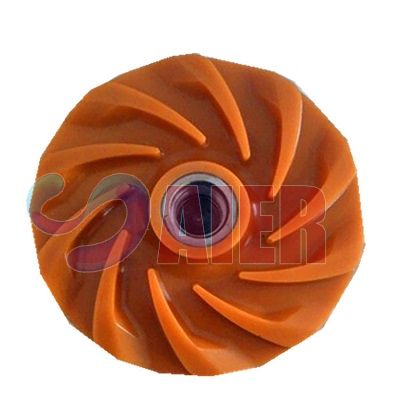Nov . 06, 2025 11:20 Back to list
Submersible Pump Impeller Manufacturer | OEM & Wholesale
Inside a Submersible Pump Impeller Manufacturer: trends, specs, and hard-won lessons
If you spend enough time on mine sites or in municipal pits (I do, sometimes knee-deep in slurry), you learn that impellers make or break uptime. Lately, the shift toward elastomer solutions—especially polyurethane—has been unmistakable. It’s not hype; it’s wear data and quieter bearings talking. Today I’m looking at a China-origin Polyurethane impeller for Warman slurry pumps, and how a seasoned Submersible Pump Impeller Manufacturer builds, tests, and customizes these parts for real-world abuse.

What’s changing (and why it matters)
Three trends keep cropping up: polyurethane formulary upgrades for sharper particle resistance, CFD-led vane tweaks that actually translate to lower NPSHr, and faster tooling via 3D scanning of legacy parts. Many customers say they’re cutting changeouts by a quarter, sometimes more. In fact, in wet sand and tailings, PU often edges high-chrome iron on life—though, to be honest, not always in hot, chemical-laden service.
Product spotlight: Polyurethane impeller (Warman-compatible)
Origin: China. Designed for AH-series style slurry and submersible slurry applications where sharp, fine solids dominate. The manufacturer offers closed and semi-open geometries; I’ve seen them spec it for 4/3C-AH through 8/6E-AH frames, with custom hub bores on request. It seems that balancing and hardness consistency are the differentiators here.
Key specifications (typical)
| Material | Cast polyurethane (abrasion-optimized) |
| Hardness | Shore A ≈ 90±5 (ASTM D2240) |
| Specific Gravity | ≈ 1.10–1.20 |
| Max Fluid Temp | ≈ 70–80°C (real-world use may vary) |
| pH Window | ≈ 3–10 continuous |
| Balancing | ISO 1940 G6.3 (typical) |
| Abrasion Loss (lab) | ASTM D5963 ≈ 80–130 mm³ |
Process flow and QA (how a solid Submersible Pump Impeller Manufacturer works)
- Formulation: prepolymer + curative tuned for fine-sand abrasion and tear resistance.
- Molding: preheated steel/aluminum molds, de-gassed pours, controlled cure cycles.
- Finishing: machining of hubs/eyes; keyway and set-screw features as required.
- Balancing: dynamic to ISO 1940 class G6.3; records archived.
- Testing: Shore A (ASTM D2240), abrasion (ASTM D5963), dimensional CMM, hydro run tests to ISO 9906 acceptance grades.
- Service life: in sand/tailings, customers report ≈ 1.2–2.0× vs some metal impellers; chemistry and temperature can narrow that margin.
Where it fits
- Submersible slurry pits, sand & gravel, tailings dams, dredging boosters, coal prep, and FGD recycle (mild). Not ideal for hot caustic or sharp pH swings beyond the window.
Vendor snapshot: picking a partner
| Vendor | Lead Time | Customization | Certs/Test | Indicative Cost |
|---|---|---|---|---|
| China-based Submersible Pump Impeller Manufacturer | ≈ 2–4 weeks | High: material tweaks, bore/hub variants | ISO 9001; ISO 9906 reports; balance sheets | Low–Mid |
| EU specialist | ≈ 4–8 weeks | Medium–High | ISO 9001; detailed material COAs | Mid–High |
| Local distributor | Stock or 1–2 weeks | Low–Medium | Basic QC docs | Mid |
Field notes and a quick case
A quarry in Southeast Asia swapped a 6/4D pump to PU impellers on a submersible slurry setup. Wear audit after ≈ 1,500 hours showed vane leading-edge loss ≈ 0.7 mm (vs ≈ 1.3 mm on prior metal impeller), vibration at 1× running speed dropped ~12%, and they stretched maintenance intervals by one week. Not a miracle, but meaningful OPEX relief. As one maintenance lead told me, “It just runs quieter, and we don’t chip edges during install.”
Compliance, docs, and what to ask for
- Performance acceptance: ISO 9906 grade checks (ask for the test curve).
- Balancing certificate: ISO 1940 G6.3 or better.
- Polymer data: Shore A (ASTM D2240), abrasion (ASTM D5963), and temperature/pH guidance.
- If tied to API installations, alignment with API 610 system practices helps—even for retrofit parts.
Actually, the bottom line is simple: pick a responsive Submersible Pump Impeller Manufacturer that shares real test data, not just glossy photos.
Authoritative references
- ISO 9906:2012 – Rotodynamic pumps, hydraulic performance acceptance tests.
- ISO 1940-1:2016 – Mechanical vibration, balance quality requirements.
- ASTM D2240 – Standard Test Method for Rubber Property—Durometer Hardness.
- ASTM D5963 – Standard Test Method for Rubber Property—Abrasion Resistance (Rotary Drum).
- API 610 – Centrifugal Pumps for Petroleum, Petrochemical and Natural Gas Industries.
- Weir Minerals, Warman Slurry Pump Handbook (latest edition).
-
Reliable FGD Pump Manufacturer China | Durable & Cost-effective Solutions
NewsNov.23,2025
-
Reliable fgd Pump Manufacturer Solutions for Emission Control | Aier Pumps
NewsNov.23,2025
-
Explore Advanced FGD Pump Factory Solutions for Cleaner Power Plants
NewsNov.22,2025
-
Reliable & Efficient FGD Pump Chinese Supplier for Cleaner Energy Solutions
NewsNov.22,2025
-
Reliable China FGD Pump Suppliers for Effective Flue Gas Desulfurization | AiEr Pumps
NewsNov.22,2025
-
China FGD Pump: Durable & Efficient Solutions for Emission Control
NewsNov.21,2025
